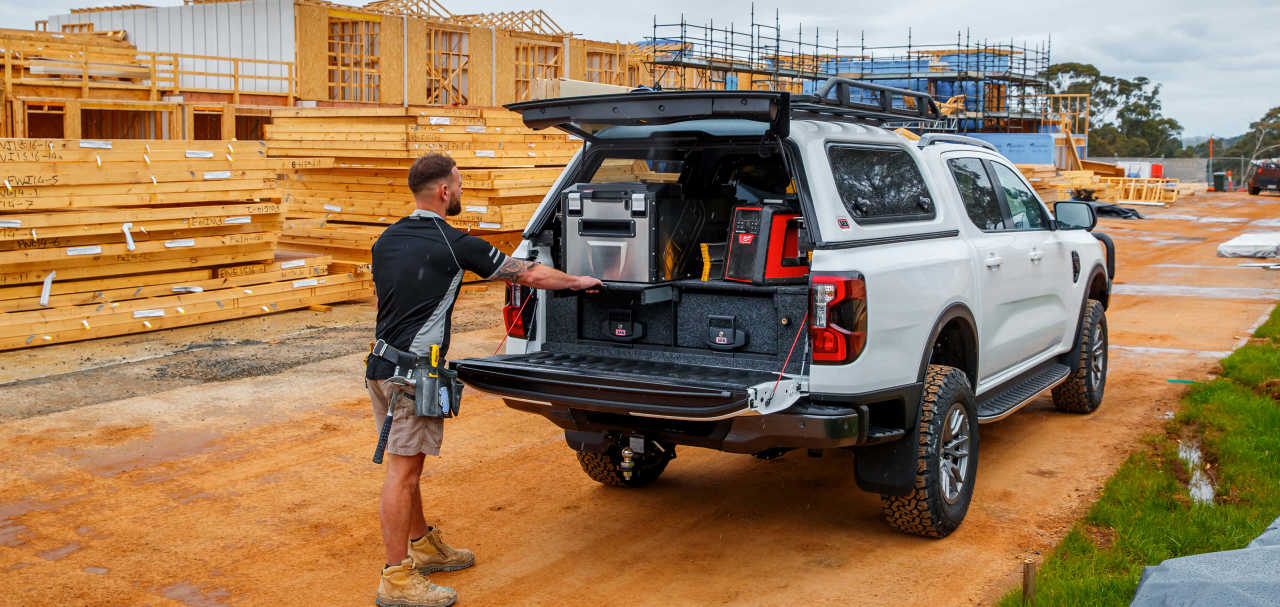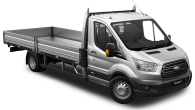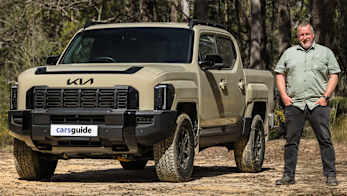The Ranger PHEV is Ford’s entry in Australia’s burgeoning PHEV (Plug-in Hybrid Electric Vehicle) ute segment pioneered by Chinese brands BYD and GWM. We recently spent a week in the work-focused entry-level model to see if this versatile vehicle could be the best ute a tradie, farmer or adventurer could ask for.
-
Ford's new pick-up gets muddy!
-
Ford’s ‘breakthrough’ electric car incoming: Blue Oval about to reveal huge electric car advancement to battle Xiaomi, BYD and Tesla
-
Next-gen electric Ford F-150 pick-up and Transit delivery van delayed in favour of smaller, more affordable 'Model T moment' EVs : reports
Ford Ranger 2026: Phev XLT (4X4)
| Engine Type | Turbo 4, 2.3L |
|---|---|
| Fuel Type | |
| Fuel Efficiency | 2.7L/100km (combined) |
| Seating | 5 |
| Price From | $71,990 |
| Safety Rating |
|
Does it represent good value for the price? What features does it come with?
8 / 10
The Ranger PHEV is available in four model grades which all share the same petrol-electric hybrid powertrain. The model ladder starts with the XLT at a list price of $71,990 and climbs through PHEV Sport ($75,990) and PHEV Wildtrak ($79,990) to the premium PHEV Stormtrak ($86,990).
So, even at base level, our XLT test vehicle is more expensive than its Chinese rivals, with the BYD Shark 6 PHEV at $57,900, before on-road costs, and GWM Cannon Alpha PHEV at $64,990, drive-away.
However, the Aussie designed and engineered Ford ute also has a long track record in Australia, market-leading sales, resilient resale values and is backed by a vast national dealer network, which are all relevant factors in determining value-for-money.

The PHEV XLT comes standard with 17-inch alloy wheels and a tyre repair/inflation kit, but a full-size spare wheel is a no-cost option. Alternatively, our example is fitted with optional 18-inch alloys and chunky 255/65R18 all-terrain tyres, which adds $700 to the price.
It also has ‘Iconic Silver’ prestige paint ($700) and the ‘Adventure Pack’ comprising a six auxiliary switch overhead panel and load tub cargo management system (sliding-rail adjustable load anchorages) which adds another $500.
The PHEV XLT comes standard with halogen headlights/front fog lamps/DRLs and LED tail-lights/rear fog lamps, black grille with active grille shutter, black side-steps, steel underbody protection, 3500kg tow-bar with electronic brake controller, a unique load-tub that incorporates the ‘Pro Power Onboard’ system (see Practicality) and more.

The cabin gets keyless entry with push-button start, electronic parking brake, fabric seat trim and carpet, but for an extra $100 buyers with muddy boots can option a vinyl floor instead.
There’s also dual-zone climate control and a six-speaker multimedia system controlled by a 12-inch portrait touchscreen that includes a dedicated off-road screen, wireless Apple CarPlay / Android Auto connectivity and digital radio. There’s also a Mode 2 (AC) charging cable.
Is there anything interesting about its design?
8 / 10
At first glance most would struggle to pick the subtle visual differences between a Ranger PHEV XLT and a turbo-diesel equivalent. These include discreet ‘PHEV’ chrome garnishes on the front fenders and an additional spring-loaded flap on the passenger side to access the traction battery's charging port.
It also has unique wheel designs which are wider than those fitted as standard to diesel variants, which along with new lip mouldings and bespoke tyres have been developed to carry the higher loads of the hybrid powertrain while maintaining payload, towing and handling ability.
The only potential negative for tradies is that the Ranger PHEV is not available in cab-chassis form and the standard load tub cannot be replaced by an aftermarket tray or service body, given the hybrid drivetrain’s traction battery and Pro Power Onboard systems are fully integrated in its design.

How practical is its space and tech inside?
9 / 10
Our XLT PHEV has a hefty 2527kg kerb weight which is 318kg more than its 2.0L Bi-Turbo diesel equivalent due largely to the extra weight of the hybrid drivetrain. However, by keeping the battery relatively small, Ford has prioritised workhorse capability over EV driving range based on customer feedback that influenced its design.
The XLT is the lightest of the four Ranger PHEV models which share the same 3500kg GVM, so it has the highest payload rating of 973kg. This is an excellent result, as it’s only 48kg less than the 2.0L Bi-Turbo diesel XLT and exceeds the payload ratings of its Chinese rivals.
The PHEV XLT also matches its diesel equivalent with a 3500kg braked tow rating and with its 6580kg GCM (or how much weight it can legally carry and tow at the same time) it can tow its maximum trailer weight with a drop in payload to 553kg, compared to 641kg for the diesel XLT.
The PHEV’s unique load tub has a floor that’s slightly higher to cater for the plug-in battery mounted in specially-designed chassis frame rails beneath it, which importantly allows the full-size spare wheel to be carried out of the way in its usual position under the tail.
The load floor is also 174mm longer at 1638mm, which combined with 1233mm between the rear wheel housings allows it to carry either a standard 1165mm-square Aussie pallet or two 800mm x 1200mm Euro pallets; the latter unmatched by the diesel XLT. The load tub also has a drop-in composite liner, lift-assisted tailgate, internal lighting and six sturdy load-anchorage points.
Like its Chinese rivals, the Ranger PHEV has V2L (Vehicle to Load) electrical capabilities. Ford’s 6.9kW system is called Pro Power Onboard comprising a single 10-amp 2.3kW three-pin electrical socket in the cabin and two 15-amp 3.45kW three-pin sockets housed in the left-side wall of the load-tub.

So, the Ranger PHEV is effectively a mobile generator, which eliminates the need to carry a portable one as it uses the vehicle’s traction battery (charged by the Ranger’s petrol engine as required) to provide potentially hours of energy for worksite equipment or campsites (see Engine).
Driver and front passenger storage includes a bottle-holder and bin in each front door plus an overhead glasses-holder and decent sized glove box with an open shelf above it. The centre console offers a phone pad and two USB ports up front, plus a handy slot for storing keys, two cupholders in the centre and a big lidded box at the back with a 12V socket inside.
The rear bench seating is spacious, given I’m 186cm and have about 60mm of headroom and 40mm of knee clearance when sitting behind the driver’s seat set in my position. Shoulder room can be squeezy for three large adults, though.
Rear passenger storage includes a bottle-holder and bin in each back door plus pockets on the rear of both front seat backrests. The rear of the centre console has adjustable air-vents plus one of the three 230V three-pin outlets for the Pro Power Onboard system.
The centre seat backrest also folds down to serve as an armrest complete with two cupholders. The bench seat’s base cushions can also swing up and be stored vertically if extra internal cargo space is required and to access two underfloor storage compartments.
What are the key stats for its engine and transmission?
9 / 10
The Ranger’s PHEV powertrain consists of a 2.3-litre turbocharged four-cylinder 'EcoBoost' petrol engine that produces 138kW of power at 4600rpm and 411Nm of torque at 2700rpm.
This is paired with a 75kW electric motor which draws its energy from the 11.8kWh lithium-ion traction battery. Combined they produce total outputs of 207kW at 4600rpm and a towering 697Nm at 2500rpm. This is the second-highest power output and highest torque output of any Ranger to date, making it ideal for heavy load hauling and towing.
A 10-speed torque converter automatic integrates the motor between the engine and transmission and offers the choice of sequential manual-shifting.

This drivetrain also offers four selectable drive modes. These comprise ‘Auto EV’ which automatically switches between the petrol engine and battery to prioritise power or fuel efficiency depending on driver demands, ‘EV Now’ which only uses battery power for maximum fuel saving, ‘EV Later’ which prioritises the petrol engine to maintain the current state of battery charge (ideal if planning to use it at your destination or for EV-only driving later) and ‘EV Charge’ for charging the battery between destinations. And if it should become depleted, the Ranger’s petrol engine switches on and starts charging to ensure continued supply.
Traction battery charging is generated by the petrol engine when idling/accelerating/cruising and the motor when decelerating/applying the brakes thanks to regenerative braking. This function can be monitored by the driver using the ‘EV Coach’ display on the instrument cluster.
The PHEV drivetrain offers 2H (2WD High Range) and a full-time 4WD setting (4A) for optimum traction in all on-road conditions. For off-road use there's 4H (4WD High Range) and 4L (4WD Low Range) which both lock the front/rear axle torque split at 50:50, plus a rear diff-lock. The driver can choose from an additional seven drive modes to tailor performance to suit specific off-road terrain and other requirements.
What is its fuel consumption? What is its driving range?
8 / 10
Ford claims an official combined average petrol consumption of only 2.9L/100km in ideal laboratory conditions, which is largely irrelevant in real-world use.
Our week of testing is a good example given a mix of suburban, city, highway and backroad driving that totalled 409km, during which we often switched between drive modes and hauled a heavy payload for about a quarter of that distance (see Driving).
The dash display was claiming a more realistic 9.3L/100km when we stopped to refuel and our own figure calculated from fuel bowser and tripmeter readings was identical, which highlights the accuracy of Ford’s onboard diagnostics. That’s also thrifty sub-10L/100km economy for a vehicle weighing more than 2.5 tonnes.

So, based on our real-world consumption figure, you could expect an ‘Auto EV’ hybrid driving range of around 750km from its 70-litre tank.
Ford also claims an electric-only driving range of up to 49km, again in ideal lab conditions, but the most we were able to achieve in the real world was 29km. However, we discovered that even that relatively short driving range was more than adequate for many urban requirements (see Driving).
The battery can only be plug-in charged using AC supply (no DC fast-charging) with a maximum charge rate of 3.5kW. However, another benefit of its relatively small battery is that it can be charged from zero to 100 per cent in less than seven hours using a standard 2.3kW domestic three-pin wall socket, as we did each night. And that charge time shortens to around four hours with a 3.5kW charger.
Using the ‘EV Charge’ mode is also efficient at charging the battery with the petrol engine when driving, as it took less than 200km to go from zero to 100 per cent.
What’s it like to drive?
9 / 10
Handling and braking are beyond criticism as is the ride quality, which is no doubt enhanced by the extra sprung weight of the PHEV hardware that helps iron out the bumps when being driven without a load.
We soon discovered that around 30km of electric-only driving range is more than adequate for the daily chores of suburban ownership within a typical 5.0-10km radius from home, where the modest performance of its 75kW motor (and we assume around 300Nm of torque) did the job with silent efficiency.
We were also impressed by the PHEV's spirited performance in petrol-electric hybrid mode, with almost 700Nm of torque ensuring a strong surge of acceleration from standing starts and outstanding load-hauling ability that belies its higher kerb weight.

The battery reserves enough charge in hybrid mode (even when it’s displaying zero) to ensure the motor is always assisting the petrol engine to deliver the PHEV’s huge combined torque output.
It’s also a quiet and effortless highway cruiser, with the petrol engine requiring only 1800rpm to maintain 110km/h.
To test its load-hauling ability we forklifted 650kg into the load tub, which with our two-man crew equalled a total payload of 830kg that was about 140kg under its legal limit.

The rear leaf-springs only compressed 45mm, with ride, handling and braking unfazed by this weight. And it easily conquered our 13 per cent gradient, 2.0km-long set climb at 60km/h without requiring the dedicated 'Tow/Haul' mode.
Regenerative braking on the way down was also robust but Ford recommends using the Tow/Haul mode on steep descents, as it prioritises engine-braking to ensure that the petrol engine and electric motor are harmonised to provide the strongest retardation.
Warranty & Safety Rating
What safety equipment is fitted? What safety rating?
8 / 10
No ANCAP rating for the PHEV model as yet, but our test vehicle has the Ranger’s full suite of benchmark passive and active safety features with nine airbags, AEB, reverse brake assist, traffic sign recognition, adaptive cruise control, front/rear parking sensors, reversing camera, tyre pressure monitoring and lots more. There’s also ISOFIX and top-tether child seat restraints for the two outer rear seating positions.
What warranty is offered? What are its service intervals? What are its running costs?
8 / 10
The Ranger PHEV comes standard with a five-year/unlimited km warranty and specific eight years/160,000km warranty for the electric drivetrain and battery. Scheduled servicing is every 12 months/15,000km with capped pricing of $399 applying for each scheduled service up to five years/75,000km, whichever occurs first.
Ford also offers pre-paid service packages with substantial savings compared to pay-as-you-go servicing. The Australian Ford dealer network has almost 200 dealerships located throughout city and regional areas, which also provide vehicle servicing.

Verdict
Ford has hit a sweet-spot with the Ranger PHEV XLT, as it can tow up to 3.5 tonnes of braked trailer, carry almost one tonne of payload and serve as a powered site anywhere you need to work or explore. Overall, it’s a well-engineered, practical and versatile all-terrain workhorse that’s as well suited to the needs of tradies and farmers as it is to adventurers.








.jpg)





















.png)







.png)









.png)








.jpg)
.jpg)
.jpg)

.jpg)

